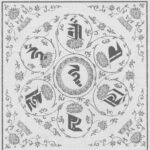| The following article is from the Winter, 2004 issue of the Snow Lion Newsletter and is for historical reference only. You can see this in context of the original newsletter here. |
by Dzogchen Ponlop Rinpoche
The following is an excerpt from a chapter by Dzogchen Ponlop Rinpoche from Snow Lion's new book Trainings in Compassion.
ENTERING THE TRAININGS IN COMPASSION
When looking at the notion of enlightenment, the possibility of becoming completely awake, the only method that can lead us to that state of total wakefulness is the practice of loving- kindness and compassion.
In the sutras, the Buddha said that in the beginning, compassion is like the seed without which we cannot have any fruit; in the middle, compassion is like water to nourish the seed we have planted; in the end, compassion is like the warmth of the sun that brings the fruit to ripening. Thus, without compassion, there is no seed of enlightenment, no path to enlightenment, and no fruition of enlightenment. The genuine heart of loving-kindness and compassion is crucial in achieving one's own freedom from suffering, and in achieving freedom for all sentient beings.
In Tibetan, the word for compassion is nying-je (Tib. snying rje), which literally means noble heart. Compassion is the most dignified, noble, and profound treasure of our heart. There is nothing more profound or precious than this heart of compassion. What is this heart of compassion? It is a genuine concern, a genuine willingness to give anything of ourselves that is necessary to alleviate the sufferings of sentient beings. Compassion also has a quality of being passionate―a genuine, innocent desire and willingness, as well as a sense of openness and bravery. Bravery here refers to not being afraid of seeing and being with suffering, and to not being afraid of where you are or who you are in any given moment.
The Vast and the Profound
The path of training in the Tibetan Buddhist tradition that focuses on the development of loving-kindness and compassion is called Mahlyna―the great vehicle. All of the many Mahlylna teachings are included within two categories: the vast and the profound. These two qualities correlate to the two types of bodhichitta, absolute bodhichitta and relative bodhichitta. Absolute bodhichitta is the profound reality, and relative bodhichitta is the vast methods for connecting to that reality.
Relative Bodhichitta: The Gateway to Absolute Truth
In order to genuinely connect with the profound reality of absolute bodhichitta, we must approach it through the vast methods of relative bodhichitta. Although the profound nature of reality may seem easy to theorize, it is actually very difficult to experience in a nonconceptual and immediate way. To work towards this nonconceptual understanding of the absolute truth, we need the path and practices of relative bodhichitta. Without such a path, our profound theories may sound nice, but they will still not have any true effect on our mindstream. In order to make manifest the profound nature of reality in our hearts and in our world, we need the vast methods of relative bodhichitta, the trainings in compassion.
Training in compassion has the capacity to be both profound and vast―both absolute and relative. Compassion has the quality of being approachable and at the same time ungraspable. It manifests both the quality of shanyatl, emptiness, or egolessness, as well as the qualities of kindness and joyfulness. Therefore, from the Mahayana point of view, compassion is the most important practice we could ever engage in. It can lead us to the full realization of enlightenment without any need for other practices.

The most effective and powerful way to deal with suffering and unpleasant circumstances is to be within those very states without any hesitation, without any kind of fear.
Our Own Pain: The First Training in Compassion
Compassion must start with seeing our own suffering. If it does not, then seeing the suffering of others will be merely conceptual. It will merely be a matter of having learned about suffering from a book or philosophy. We may intellectually know about the different types of suffering and so forth, but without inward reflection, our understanding will always be a theoretical knowledge that is directed toward the outside. Starting from our own experience of suffering becomes most important for the practice of open and genuine compassion.
Being present with the immediate experience of our own suffering is, from a certain perspective, a great spiritual practice. Yet from another perspective, we have no choice but to be accompanied by our suffering. Therefore, why not use our suffering in a positive way, instead of wasting our time? Our usual reaction to suffering Is to want to be somewhere else or someone else as soon as it arises. If such wishing actually improved our suffering, then perhaps there would be an argument for staying with that approach. Yet, as we know, regardless of what escape routes we create, we will still be stuck with our headaches, our painful emotions, and our irritations.
The most effective and powerful way to deal with suffering and unpleasant circumstances is to be within those very states without any hesitation, without any kind of fear.
Fear and Fearlessness
Perhaps the first reaction we have to our own suffering is fear. Fear arises in us almost automatically when we experience strong emotions or pain. We don't have to sit there and generate fear―it just arises. When we experience a disturbing emotion such as jealousy we think, No, I don't want this. We would rather not experience it. However, if we examine fear closely, we see that it is a thought to which we have been habituating our mind for a very long time. We have repeated this thought pattern of fear for many years, and from a Buddhist point of view, many lifetimes.

Illustrations from Trainings in Compassion by Chris Banigan
In just the same way, when we habituate our minds to being fearless, to being brave and open towards our emotions, fearlessness will also arise naturally. In order for this to happen we must train in applying antidotes to our thought patterns that are caught up in fear. In this way, we transcend fear first through a conceptual process, which later becomes nonconceptual, a natural fearlessness. In order to become fearless in this way, we need determination and the willingness to face our emotions. With that strong determination and courage, fearlessness will arise effortlessly.
Compassion and Egolessness
Compassion, this genuine heartfelt concern for others, arises on the basis of a certain degree of understanding egolessness. When you give love to someone without any ego or self-interest, that love and concern is genuine compassion, the noble heart. As long as we have a strong ego, our practice of compassion will still be slightly selfish and not very genuine. Such compassion involves an uncertain motivation, a motivation that mixes the interests of other beings with our own self-interest. Therefore, in order to make our compassion more genuine, we need to also be familiar with the understanding of egolessness―selflessness―the absolute nature of compassion. The most genuine and absolute nature of compassion is completely free of any ego.
Checking our Motivation
When we extend compassion, it is important for us to reflect on what our motivations are. What is our heart saying when we are trying to take on the suffering of others, when we are trying to give others happiness? Sometimes we do things that may look like compassionate acts, but in fact they are actually more selfish than compassionate. For example, when we have a pet dog or ca t and they are sick or dying, we feel terrible. We feel sad and full of compassion towards that being. When they are gone, we shed tears for many days and experience the pain of losing them. Yet when we examine our hearts, are we really shedding these tears with genuine concern for the interests of that being? Or are we shedding these tears because we miss their companionship? If it is the former, then our compassion is genuine. However, if it is the latter, then that is a self-centered motivation. Our main motivation is not compassion for our pet, but rather our own desire not to be alone after losing their companionship. Starting from such examinations, we can check our attitude continually and see how genuine the compassion is that we are trying to make manifest.

